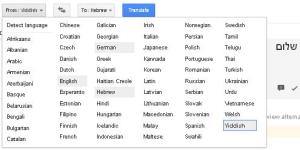Turn automatic translation of Yiddish or Hebrew into natural language. One famous Yiddish English Hebrew Dictionary you have forgotten about!
Do you want to translate Yiddish to Hebrew? Hebrew to English? English to Yiddish? Whatever you want to do, long as these three languages are involved, there is (unfortunately) just one place to look:
P.S. I just realized that I had a long lost Yiddish-English-Hebrew dictionary, honestly one that I never needed (I have no interest in learning Yiddish at all). But while doing some research on it for this page, I just found out that it is the only work of its kind. It was first published in the 1980’s and everybody seems to be hyper-happy about it. I honestly could care less. However, the dictionary has been re-printed (not re-edited, it seems) and available on Amazon. It is not that cheap though. Take a look here.
So, back to our online translation. Here is he one place to look that I was talking about:
Google Translate! (Oops, continue reading)

Google translation service used to be completely ridiculous, giving you translations that you usually would get embarrassed to use in an email to your business partner or even to a friend. But time has changed and Google Translation has really grown up so much.
So, can I trust Google Translate completely?
A funny saying in Egypt goes like “I only trust my mother, and if she divorces my father, I would start getting suspicious”. So of course you cannot trust Google blindly, though you don’t really have to distrust it too. You should simply review the translation it provides you. You don’t have to be speaking Hebrew or Yiddish to do so, but you will have to follow guidelines that I will try to develop here on this page overtime. I will cover here the Hebrew part, I am not an expert with Yiddish, so I will leave this for folks who are in a better position than I am.
So, to review automated translation:
P. S. I am assuming that you know how to read the Hebrew alphabet. If not, then you can carefully study this Hebrew Alphabet Chart first.
1: Hebrew differentiates between singular and plural second person.
As you know, there is no “you” and “y’all” in proper English. You talk to one person you call him “you” and you talk to one thousand people at a conference and you call them “you”. This is different in Hebrew. And Google can’t usually tell!
If you want to write an email to a company that you work with, and you want to talk to the team in plural form, you want to say for instance “I do not understand what you say”. You put this to Google and it translates it as:
אני לא מבין מה אתה אומר – ani lo mevin ma ata omer.
This literally means what you have asked for, except for the fact that this could only be said to one man, not a group of people.
The proper form should be
אני לא מבין מה אתם אומרים – Ani lo mevin ma atem omrim.
So you have to look into the Hebrew pronouns and find out how to differentiate between plural and singular pronouns, you don’t have to memorize the, just keep the list in front of you while you are quickly reviewing the text.
TIP FOR LAZY PEOPLE: You can now add the word “guys” after “you” and Google will realize then that you are talking to more than one person, however, Google usually will not mention the word “guys” in the translation.
2: Hebrew differentiates between masculine and feminine second person.
So, applying the same example, when you want to tell a woman “I do not understand what you say”, Google will assume you are talking to a man! So the same translation would be
אני לא מביןמה אתה אומר – Ani lo mevin ma atta omer.
while the proper translation should be:
אני לא מבין מה את אומרת – ani lo mevin ma at omeret.
More tips are to come.
I will be adding more tips here on how to review Google translation to make it more human-like nature language. Just thought it would be a good idea to wait and see if the article was helpful at all. Drop me a comment and speak up your mind.
It would be fun if you put here some of the translations you got and how you tried to “naturalize” them using Hebrew grammar (or Yiddish, though I can’t assist with this one). We could help each other making them better.
